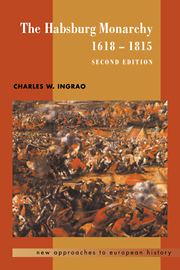Book contents
- Frontmatter
- Contents
- List of maps
- Genealogical tables
- Preface
- 1 The distinctiveness of Austrian history
- 2 The Thirty Years' War (1618–1648)
- 3 Facing east: Hungary and the Turks (1648–1699)
- 4 Facing west: the second Habsburg empire (1700–1740)
- 5 The Prussian challenge: war and government reform (1740–1763)
- 6 Discovering the people: the triumph of cameralism and enlightened absolutism (1765–1792)
- 7 The age of revolution (1789–1815)
- 8 Decline or disaggregation?
- Bibliography
- Index
- More titles in the NEW APPROACHES TO EUROPEAN HISTORY series
Preface
- Frontmatter
- Contents
- List of maps
- Genealogical tables
- Preface
- 1 The distinctiveness of Austrian history
- 2 The Thirty Years' War (1618–1648)
- 3 Facing east: Hungary and the Turks (1648–1699)
- 4 Facing west: the second Habsburg empire (1700–1740)
- 5 The Prussian challenge: war and government reform (1740–1763)
- 6 Discovering the people: the triumph of cameralism and enlightened absolutism (1765–1792)
- 7 The age of revolution (1789–1815)
- 8 Decline or disaggregation?
- Bibliography
- Index
- More titles in the NEW APPROACHES TO EUROPEAN HISTORY series
Summary
Neville Chamberlain spoke for millions of his British contemporaries when, at the height of the Munich Crisis, he lamented the prospects of going to war over “a faraway country” inhabited by “people of whom we know nothing.” The prime minister was, of course, speaking of Czechoslovakia. But he could have just as easily used these same words to characterize his knowledge – or concern – about the other lands and peoples of the former Habsburg monarchy. A half century later even the educated public in western societies like Great Britain and the United States still know very little about the region, and even less about its history. Nor should this come as a surprise. Neither a bygone empire nor the small “successor states” that replaced it can inspire the same interest as great modern entities like France, Germany, or Russia. Yet, even before its dissolution in 1918, the monarchy's diversity made it much more difficult to comprehend, thereby discouraging anyone from investigating it in the first place. Part of the reason is that the monarchy was really three different countries at the start of the seventeenth century, each nested with several smaller, but distinct sub-societies. In many respects they remained disparate throughout its history. Of course, the same can be said of other European societies. But whereas it is possible to write Soviet or Russian history from the Great Russian perspective, and British history from an English viewpoint, the component states of the Habsburg monarchy were much too numerous, populous, and wealthy to be ignored, either by the Habsburgs or by those who study it.
- Type
- Chapter
- Information
- The Habsburg Monarchy, 1618–1815 , pp. xi - xivPublisher: Cambridge University PressPrint publication year: 2000

